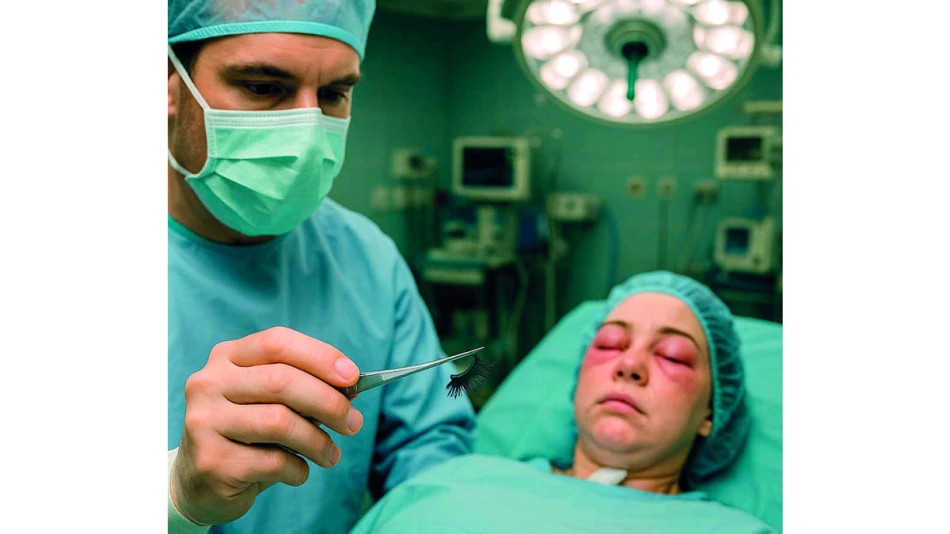
Artificial Lashes: The Risky Beauty Trend Causing Eyelid Burns and Partial Blindness
Doctors are raising urgent warnings about artificial eyelashes after seeing a sharp rise in serious eye injuries. What started as a beauty trend is now causing severe corneal infections, permanent eyelash loss, and in some cases, temporary vision problems or partial blindness.
The popularity of fake eyelashes has exploded thanks to social media and celebrity influence. Long, thick lashes have become a symbol of modern beauty standards. But here's the problem - many salons market these procedures as quick and safe, when they actually require strict medical precautions.
Dr. Anwar Al Hamadi, a dermatology specialist, explains that most eyelash adhesives contain special glues that release formaldehyde when they break down. This chemical irritates and sensitizes the skin around the eyes. The dyes used in some products can also trigger allergic reactions.
There are two main types of allergic reactions doctors are seeing. The first is allergic contact dermatitis - itching, redness, and peeling of the eyelid. The second is chemical irritation, usually from poor-quality adhesives or bad application techniques.
Not all fake eyelashes carry the same risk level. Daily strip lashes that you remove each night are relatively safer. But semi-permanent extensions that stay on for weeks are much more dangerous. They can cause chronic inflammation along the eyelid edges, increase infection risk, and lead to natural eyelash loss.
Dr. Al Hamadi strongly advises against artificial lashes for anyone with a history of allergies, eczema, dry eyes, contact lens wearers, or people who've had laser eye surgery. Clinics are now seeing more cases linked to at-home application kits and social media trends promoting DIY eyelash extensions.
Four groups of women should completely avoid artificial eyelashes: those with skin allergies or eczema around the eyes, women with recurring eyelid infections or hair loss conditions like alopecia, recent eye surgery patients, and pregnant or breastfeeding women.
Dr. Sara Yaqoub, a dermatology and cosmetics specialist, points to safer alternatives. Medical serums containing peptides can stimulate natural lash growth. Low-energy LED light therapy improves blood circulation around the eyes. Proper nutrition with biotin and zinc also supports hair growth. There are FDA-approved treatments like Latisse that work under medical supervision.
The biggest mistakes happening in salons include using adhesives with formaldehyde, attaching lashes directly to skin instead of hair follicles, reusing tools between clients, and removing extensions violently without proper solvents. These practices lead to blocked pores, infections, and permanent damage to natural lashes.
Eye specialist Dr. Pavli Muawad Hanna warns that repeated use of artificial lashes disrupts the eye's natural protection system. Natural lashes act as shields against dust and particles while helping distribute tears across the cornea. Heavy artificial lashes interfere with this vital function and can block tiny pores responsible for eyelid moisture.
Five warning signs require immediate medical attention: severe redness or burning pain, sudden vision changes or blurriness, obvious eyelid swelling, excessive discharge or tearing, and light sensitivity or difficulty opening the eye. These symptoms could indicate serious complications like corneal ulcers.
Doctors have documented cases ranging from surface eyelid infections to severe corneal injuries from adhesive leakage. Some patients needed surgical removal of artificial lashes and antibiotic eye cleaning. Others suffered permanent natural eyelash loss when hair follicles were damaged beyond repair.
The medical advice is clear: avoid unlicensed materials like black henna containing PPD chemicals, super glue, and unknown adhesives sold online. Choose reputable salons using licensed, sterile products. Give natural lashes rest periods between applications. Remove makeup gently without rubbing the eye area.
The beauty industry's push for dramatic lashes is creating real medical problems. While the desire for attractive eyes is understandable, the risks of artificial eyelashes often outweigh the cosmetic benefits. Natural alternatives and proper eyelash care offer safer paths to the look many women want.
Most Viewed News

 Sara Khaled
Sara Khaled






